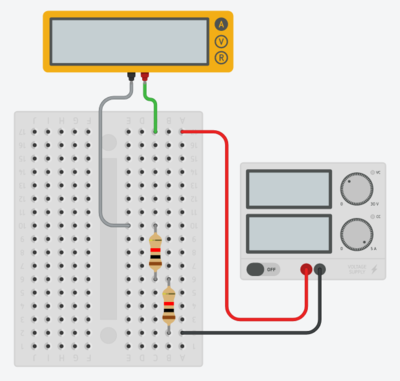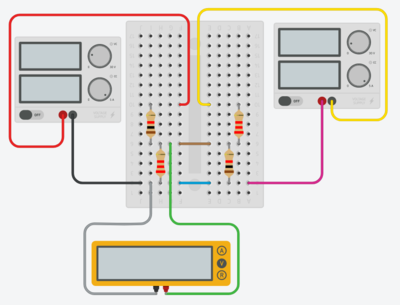Difference between revisions of "EGR 224/Circuit Building and Measurements"
| Line 11: | Line 11: | ||
* A powered breadboard - if not, move to a different table. There should red, yellow, and black cables already attached to the V+, V-, and GND posts of the PBB. Be sure the PBB is off. | * A powered breadboard - if not, move to a different table. There should red, yellow, and black cables already attached to the V+, V-, and GND posts of the PBB. Be sure the PBB is off. | ||
* A multimeter inside a cardboard box. The box should also have a white cable and a green cable as well as six resistors - two 1 k$$\Omega$$ (brown-black-red-gold), two 2.2 k$$\Omega$$ (red-red-red-gold), and two 1 M$$\Omega$$ (brown-black-green-gold) | * A multimeter inside a cardboard box. The box should also have a white cable and a green cable as well as six resistors - two 1 k$$\Omega$$ (brown-black-red-gold), two 2.2 k$$\Omega$$ (red-red-red-gold), and two 1 M$$\Omega$$ (brown-black-green-gold) | ||
| − | * | + | * Seven wires - red, yellow, black, green, white, brown or orange, and blue or purple. |
When you enter lab, check to make sure you have all the things. Before you '''leave''' the lab, make sure a TA checks you off for still having all the things! | When you enter lab, check to make sure you have all the things. Before you '''leave''' the lab, make sure a TA checks you off for still having all the things! | ||
Revision as of 04:39, 15 March 2022
$$ \newcommand{\E}[2]{#1_{\mathrm{#2}}} $$ This page will contain some tips and pictures for the EGR 224 Labs on Circuit Building and Measurements. It has been updated for Spring 2022.
Contents
Introduction
To do this lab you will need to understand how to use the following:
- Resistor Color Codes for determining nominal resistor values and tolerances,
- How breadboards work and specifically how the PBB 272 powered breadboard (hereafter, PBB) works, and
- How multimeters work and specifically how the MS8264 multimeter works.
Inventory
At your lab bench, check to make sure you have:
- A powered breadboard - if not, move to a different table. There should red, yellow, and black cables already attached to the V+, V-, and GND posts of the PBB. Be sure the PBB is off.
- A multimeter inside a cardboard box. The box should also have a white cable and a green cable as well as six resistors - two 1 k$$\Omega$$ (brown-black-red-gold), two 2.2 k$$\Omega$$ (red-red-red-gold), and two 1 M$$\Omega$$ (brown-black-green-gold)
- Seven wires - red, yellow, black, green, white, brown or orange, and blue or purple.
When you enter lab, check to make sure you have all the things. Before you leave the lab, make sure a TA checks you off for still having all the things!
Resistance Measurements
Do not hold the resistors when taking resistance meaurements - use the alligator clip cables to connect the leads of the resistor to the probes of the multimeter. Make sure the multimeter is set to measure resistance with the smallest usable range in order to get the highest possible precision. On the MS8264, resistance measurements are generally near the top of the dial.
Voltage Divider
Voltage Measurements
There are three different measurements you need to make. The first will be the total voltage - go by what your multimeter says and not by the digital readout on the powered breadboard. The second will be measuring the voltage drop across the top resistor (A), and the third will be measuring the voltage drop across the bottom resistor (B).
Current Measurement
Schematics
These are Tinkercad representations of how you should build your physical circuits. Your wiring should generally match these.
- The top left resistor is $$\E{R}{1ka}$$ and the bottom left resistor is $$\E{R}{2.2ka}$$.
- The top left source is the positive voltage source from the powered bread board (PBB) - the black wire is the ground wire and the red wire is the positive voltage wire. The top right source represents the negative voltage source from the PBB and the yellow wire represents that negative voltage. The pink wire will not actually physically exist on your circuit; both the positive and negative sources on the PBB are connected the same ground but Tinkercad actually needs two separate connections.
- The brown wire in the top picture may be orange for you; it is meant to connect the subnode attached to $$\E{R}{1ka}$$ and $$\E{R}{2.2ka}$$ to the subnode attached to $$\E{R}{1kb}$$ and $$\E{R}{2.2kb}$$; it is the wire through which $$\E{i}{y}$$ flows. In the second figure, note that the wire has been replaced by the multimeter in ammeter mode.
- The blue wire in the figure may be purple for you - it is meant to connect the ground of the PBB and the bottom of $$\E{R}{2.2ka}$$ to the bottom of $$\E{R}{1kb}$$; the negative voltage source is internally connected to the same ground as the positive voltage source (which is why the pink wire in the drawing will not show up in your circuit).



